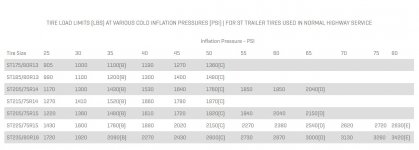The original tires for my Heartland Wilderness seemed marginal for load capacity.
I had a blowout after about 4,000 miles.
The label for the tire and load information says Class C tires at 50 psi.
I replaced the Class C tires with Class D tires which are rated at max. pressure of 65 psi.
I have run the new tires at 60 psi for about 1,000 miles. I find the trailer handles better (less sway).
Are Class D tires better for my travel trailer?
Is there any danger with running the Class D tires at 60 psi?
I had a blowout after about 4,000 miles.
The label for the tire and load information says Class C tires at 50 psi.
I replaced the Class C tires with Class D tires which are rated at max. pressure of 65 psi.
I have run the new tires at 60 psi for about 1,000 miles. I find the trailer handles better (less sway).
Are Class D tires better for my travel trailer?
Is there any danger with running the Class D tires at 60 psi?

